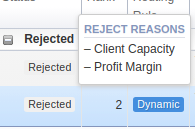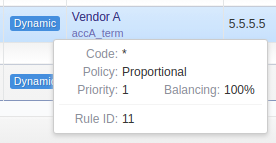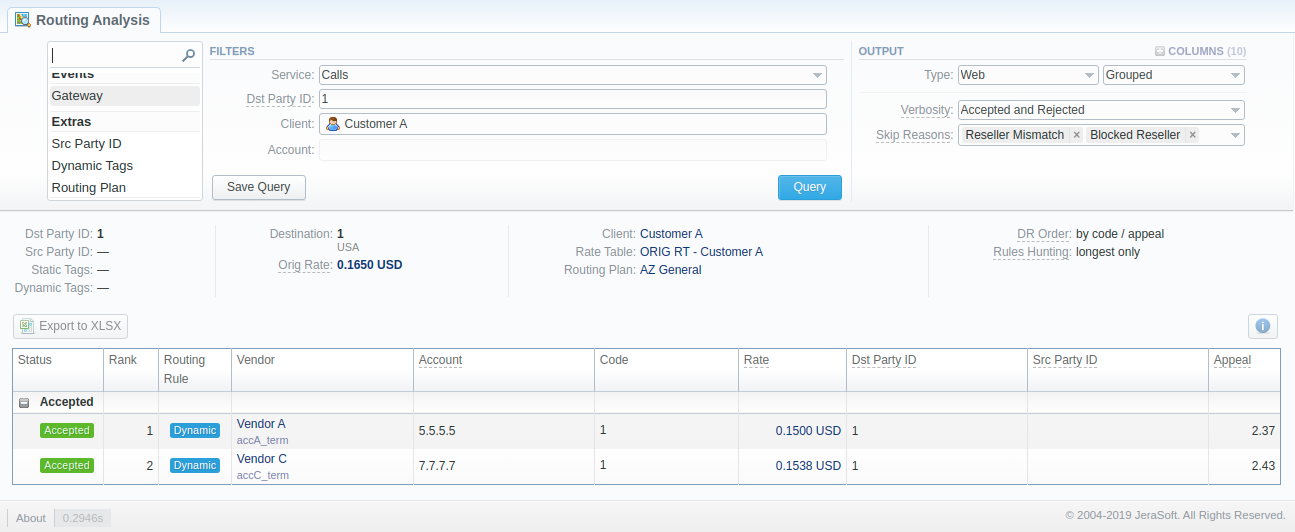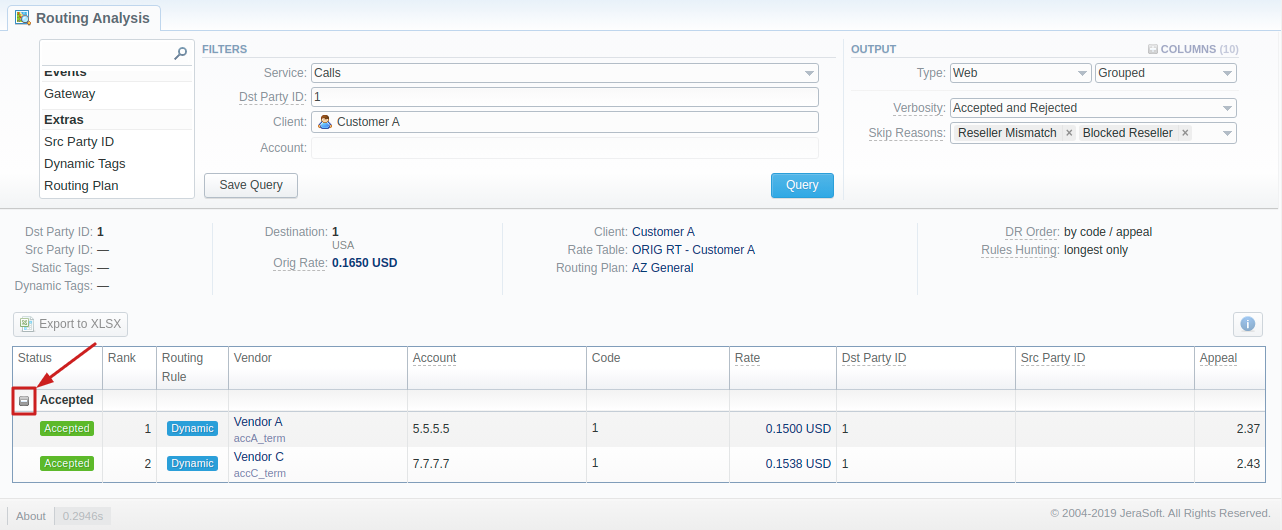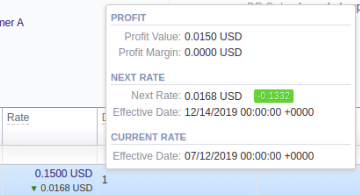Docs for all releases
View User Guide 3.26 or visit our current documentation home page.
Section overview
This section represents a route analyzer tool that allows to manage dynamical routes and simulate different routing models without hurting live voice traffic. It should be noted that this tool can be used only in case you are using the Dynamic Routing feature.
The Routing Analysis section represents a query form with the following parameters:
Screenshot: Routing Analysis form
Attention
Please note that if there are changes in the Term Rate Table, you need to launch Dynamic Routing Manager in the Task Scheduler section (System > Task Scheduler). Routing Analysis shows routes based on the routing table built on the last run of the Dynamic Routing Manager. So you won't be able to see the latest changes regarding Routing Rules until Dynamic Routing Manager is restarted.
Creating a Routing Analysis Report:
To generate routing analysis, enter the next parameters in the query form:
| Section | Field Description | |
|---|---|---|
| Filters | Select desired parameters for the report in the Filters menu. To cancel any filter, click the delete icon next to the filter. You can use a quick search by typing filters' names in the respective field at the top of the filters list. | |
| Service | Select the service for the report. By default, the field value is set to Calls. This field is mandatory. | |
| Dst Party ID | Enter the destination party ID to define a destination. This field is mandatory. | |
| Client | Select a client for the report. Also, you can specify respective call shops. This field is mandatory. | |
| Account | Select an account for the report. | |
Additional Filters | ||
There are the following accessible additional filters:
| ||
| Events Settings | ||
| Gateway | Define a gateway specified in the term account | |
| Extra Settings | ||
| Src Party ID | Specify a source number or any other source identification to check the translations | |
| Dynamic Tags | Enter additional dynamic tags for this routing | |
| Routing Plan | Enter the plan with a respective routing rule | |
| Output | This form contains settings of the output data of the report. Click the plus icon near Columns to select respective columns to output report data. Also, you can cancel any chosen item. | |
| Accessible columns in the report | ||
Following columns can be added to the report: Status, Rank, Routing Rule, Vendor, Account, Code, Rate, Dst Party ID, Src Party ID, Appeal, Reject Reasons. | ||
| Status | The following information is displayed in the column: the state of the route, reject reasons (if any) for accepted route for rejected route due to some reasons (to see them, hover over the icon) To view detailed information on a rejected route status, hover over a corresponding icon in the column. Screenshot: Detailed information on a route status | |
Rank | Vendor position during routing. It's applicable and the system puts values in order when route status is accepted. | |
| Routing Rule | Type of the route that includes: destination, policy and rule properties (balancing, priority), time profile, orig groups, term groups, debug information A grey icon in the column shows a static route A violet icon indicates a DID route A blue icon in the column shows a dynamic route To view detailed information on a route type hover over a corresponding icon in the column. Screenshot: Detailed information on a routing rule | |
| Vendor | The name of the respective terminator specified in the Client's settings and its account name | |
| Account | The name or IP of the account | |
| Code | Here you can see matched code in the terminator's rate table | |
| Rate | Rate that is used to terminate the call | |
| Dst Party ID | Shows destination party ID that is sent to the provider when all matching number translations are performed | |
| Src Party ID | Shows source party ID after all number translations | |
| Appeal | Shows the appeal automatically calculated by the system according to the chosen DR Policies (Routing section > DR Policies) The Appeal is displayed as a value if a route is dynamic. If a route is static, it's displayed as N/A. Regardless of the route type, you can hover over the appeal value to get additional insights on ASR, ACD, SCD, PDD, Vendor Debt, Payment Due, Stats Qty. | |
| Reject Reasons | Displays respective rejection reasons for a particular route | |
| Other output settings | ||
| Type | Choose a format of the report from a drop-down list: Web/CSV/Excel XLS/Excel XLSx. Also, select a look of table view next to the Type field:
Please note that the Grouped type of a table view is available only for Excel XLSx and Web formats, it doesn't work with CSV or Excel XLS. If CSV, Excel XLS or Excel XLSx type has been selected, an additional Send to field will be displayed. In this field you can specify emails of the clients, where the current report in the selected format will be sent. | |
| Verbosity | Select which routes should be displayed (accepted and rejected, or accepted only). | |
| Skip Reasons | Specify the reasons under which routes should be excluded from the output list. The available skip reasons are:
| |
After selecting all needed parameters, click the Query button and the system will generate a report.
Screenshot: Routing Analysis
Moreover, you can create (save) and display previously saved report templates by сlicking Save Query and Load Query respectively. Keep in mind that the load button will be present only if there is at least one routing analysis report in the Report Templates section.
To find more details about templates, please refer to the Report Templates article in our User Guide.
Attention
Please mind the naming of your codes. For example, if your client has:
- a 447911 code in a Rate Table,
- an assigned Code Deck that has only 44-UK, but not 447911,
- an assigned Routing Plan with a static rule for UK to a vendor,
in the Routing Analysis you will not see this vendor as available for a call to, say, 4479110000, even though the Orig parameters state a Code Name as UK. This happens, because it's a simulated Code Name (from 44 Code, present in a Code Deck).
If you'd like to see the said vendor, the code should be either 447911, or 44*.
To expand or collapse data in your report, click the plusor minusicons. If the data is Grouped in the report, it will be shown initially expanded.
Screenshot: Expand/collapse report data
If applicable, you can check the future terminator's rate, its effective date, and profit in the report by hovering over a current rate in the Term Rate column.
Screenshot: Future Terminator's Rate
Please note that it analyses the profitability by comparing orig and term rates. Therefore, an orig rate should be equal or greater than a term rate and profit margin.
Attention
Please note that if a Reseller has an orig rate assigned, the profit margin will be counted taking into account both client-originator's rate and Reseller's rate.
By hovering over the Info icon above the report on the right, user's name and time/date when a report was generated will be displayed in a pop-up window.
Screenshot: Info icon
Export a generated report
You can export report data either in a .xlsx or .csv file that would contain currently presented data. Click the Export to XLSx or Export to CSV button to download a file of the respective format. Be advised that the Export to CSV button is only available if Output is set to Web/Plain.
Attention
Please note:
- Inactive additive rates with non-zero value (for respective tags) won't be shown. Active additive rates with zero value will be shown.
- If you change the currency in the Settings, you need to restart Dynamic Routing Manager in the Task Scheduler section for immediate Routing Analysis functioning.
Sharing a Report
Each time you get a report output, the system generates a unique link in the format of "/view?id=<uniq-string>". It allows sharing data between the users, even if they belong to different resellers (the feature works similarly to Share by Link in Google Drive).
The link refers to the report data valid for a specific moment.
Example: When you send a link to a report, you ensure the recipient would see the same data as you do. If you change data in the system (for example, perform rerating), the previously copied link to the report will display data valid for the moment of generation (even though the actual data is now different).
You can also view the additional information about the generated report by hovering over the Info icon, which is located under the Output section:
Title | Description |
|---|---|
| Generated by | Indicates the Role of the user who generated a report and specifies a generation time |
Screenshot: Routing Analysis Info icon
Knowledge Base Articles

